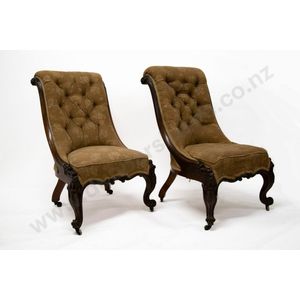Victorian Rosewood Scroll Back Parlour Chairs with Button Upholstery
A pair of early Victorian rosewood scroll back parlour chairs, upholstered in button back moquette, acanthus leaf tops on cabriole forelegs
You must be a subscriber, and be logged in to view price and dealer details.
Subscribe Now to view actual auction price for this item
When you subscribe, you have the option of setting the currency in which to display prices to $Au, $US, $NZ or Stg.
This item has been sold, and the description, image and price are for reference purposes only.
- Victorian Period - The Victorian period of furniture and decorative arts design covers the reign of Queen Victoria from 1837 to 1901. There was not one dominant style of furniture in the Victorian period. Designers used and modified many historical styles such as Gothic, Tudor, Elizabethan, English Rococo, Neoclassical and others, although use of some styles, such as English Rococo and Gothic tended to dominate the furniture manufacture of the period.
The Victorian period was preceded by the Regency and William IV periods, and followed by the Edwardian period, named for Edward VII (1841 ? 1910) who was King of the United Kingdom and the British Dominions and Emperor of India for the brief period from 1901 until his death in 1910. - Acanthus - A stylized leaf motif, one of the primary decorative elements of classical Greek and Roman architecture, derived from the genus of flowering plants in the family Acanthaceae, native to tropical and subtropical regions of the Mediterranean area. It is a common element in classical Greek and Roman design, and is often seen in Corinthian and Composite order columns and used as a decorative element in English, European and Australian furniture, particularly on the curve of a leg, and as decoration for a corbel.
- Rosewood - A dense timber that varies in shade to very light brown to almost black. When rosewood is cut and sanded the colour of the timber will turn black, and after polishing and exposure to daylight, the surface will gradually lighten over time to light brown with black streaks.
The name comes from the odour emanating from the timber when it is planed, sanded or cut.
Rosewood was very popular for use in Victorian furniture in the second half of the 19th century, and at that time most of the rosewood was imported from Brazil. However it also grows in India and Indonesia.
It is used in the sold for chairs and table legs, but for carcase furniture such as side cabinets and bookcases, and for table tops it is always used as a veneer. - Moquette Fabric - Moquette fabric is made using a combination of cotton, wool, and synthetic fibres, using a weaving technique known as jacquard and is known for its durability and resistance to wear and tear. Cut and uncut threads form a short, dense pile and a distinctive pattern of raised dots or loops, which helps to make it resistant to stains and dirt.
- Moquette - Moquette is a heavy woven upholstery fabric with a thick nap, renown for its hard wearing and durable qualities. Moquette is used as the upholstery fabric on the London buses and the Underground.
This item has been included into following indexes:
-
chairs, singles / pairs / threes, style or period
- parlour 49
- Victorian, other styles 1,208
- chairs, singles / pairs / threes, timber - rosewood 109
